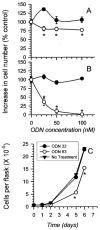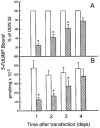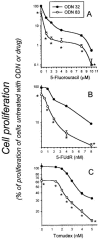Antisense down-regulation of thymidylate synthase to suppress growth and enhance cytotoxicity of 5-FUdR, 5-FU and Tomudex in HeLa cells
- PMID: 10482907
- PMCID: PMC1566173
- DOI: 10.1038/sj.bjp.0702728
Antisense down-regulation of thymidylate synthase to suppress growth and enhance cytotoxicity of 5-FUdR, 5-FU and Tomudex in HeLa cells
Abstract
1. Thymidylate synthase (TS), the key enzyme in de novo synthesis of thymidine, is an important target for antitumour chemotherapy. It was hypothesized that antisense oligonucleotide down-regulation of TS mRNA would decrease TS levels and enhance the cytotoxicity of inhibitors of TS, including the pyrimidine analogues 5-fluorouracil (5-FU) and 5-fluorodeoxyuridine (5-FUdR), and the folate analogue Tomudex (ICI D1694; N-(5-[N-(3, 4-dihydro-2-methyl-4-oxoquinazolin-6-ylmethyl)-N-methylamino ]-2-theon yl-L-glutamic acid). 2. 2'-Methoxyethoxylated, phosphorothioated 20-mer oligodeoxynucleotides (ODNs), complementary to various sequences in TS mRNA, were synthesized, along with control oligomers consisting of the same, respective bases in randomized order, against which all the biological effects were compared. Following a 6-h transfection of HeLa cells using polycationic liposome at 3 microg ml(-1), ODN 83 (50 nM), complementary to a region in the 3'-untranslated region of the TS mRNA, decreased TS mRNA levels by approximately 70% within 24 h. ODN 83 also decreased TS enzyme activity, as measured by binding of TS to radiolabelled 5-fluorodeoxyuridine monophosphate. In addition to inhibiting proliferation by up to approximately 40%, ODN 83 enhanced the cytotoxicity of Tomudex or 5-FU, added 1 day following transfection, by 50 - 60%. ODN 83 also enhanced sensitivity to 5-FUdR by 70%, but did not affect the toxicity of cisplatin, chlorambucil, melphalan, doxorubicin, ionizing radiation, paclitaxel, or irinotecan. 3. These data indicate that antisense ODN down-regulation of TS can inhibit human tumour cell proliferation and enhance the efficacy of TS-targeted drugs.
Figures






Similar articles
-
Antisense-induced down-regulation of thymidylate synthase and enhanced cytotoxicity of 5-FUdR in 5-FUdR-resistant HeLa cells.Br J Pharmacol. 2001 Dec;134(7):1437-46. doi: 10.1038/sj.bjp.0704394. Br J Pharmacol. 2001. PMID: 11724749 Free PMC article.
-
A "combination oligonucleotide" antisense strategy to downregulate thymidylate synthase and decrease tumor cell growth and drug resistance.Cancer Gene Ther. 2003 Apr;10(4):278-86. doi: 10.1038/sj.cgt.7700566. Cancer Gene Ther. 2003. PMID: 12679800
-
The means to an end of tumor cell resistance to chemotherapeutic drugs targeting thymidylate synthase: shoot the messenger.Curr Drug Targets. 2002 Aug;3(4):297-309. doi: 10.2174/1389450023347605. Curr Drug Targets. 2002. PMID: 12102601 Review.
-
Antisense targeting of thymidylate synthase (TS) mRNA increases TS gene transcription and TS protein: effects on human tumor cell sensitivity to TS enzyme-inhibiting drugs.Gene Expr. 2007;13(4-5):227-39. doi: 10.3727/000000006780666993. Gene Expr. 2007. PMID: 17605297 Free PMC article.
-
Downstream molecular determinants of response to 5-fluorouracil and antifolate thymidylate synthase inhibitors.Ann Oncol. 2000 Apr;11(4):385-91. doi: 10.1023/a:1008351221345. Ann Oncol. 2000. PMID: 10847455 Review.
Cited by
-
Mechanistic evaluation of the signaling events regulating curcumin-mediated chemosensitization of breast cancer cells to 5-fluorouracil.Cell Death Dis. 2013 Feb 21;4(2):e505. doi: 10.1038/cddis.2013.26. Cell Death Dis. 2013. PMID: 23429291 Free PMC article.
-
Antisense-induced down-regulation of thymidylate synthase and enhanced cytotoxicity of 5-FUdR in 5-FUdR-resistant HeLa cells.Br J Pharmacol. 2001 Dec;134(7):1437-46. doi: 10.1038/sj.bjp.0704394. Br J Pharmacol. 2001. PMID: 11724749 Free PMC article.
-
Effect of 2'-O-methyl antisense ORNs on expression of thymidylate synthase in human colon cancer RKO cells.Nucleic Acids Res. 2001 Jan 15;29(2):415-22. doi: 10.1093/nar/29.2.415. Nucleic Acids Res. 2001. PMID: 11139611 Free PMC article.
-
Thymidylate synthase as a determinant of pemetrexed sensitivity in non-small cell lung cancer.Br J Cancer. 2011 May 10;104(10):1594-601. doi: 10.1038/bjc.2011.129. Epub 2011 Apr 12. Br J Cancer. 2011. PMID: 21487406 Free PMC article.
-
Expression of Ribonucleotide Reductase Subunit-2 and Thymidylate Synthase Correlates with Poor Prognosis in Patients with Resected Stages I-III Non-Small Cell Lung Cancer.Dis Markers. 2015;2015:302649. doi: 10.1155/2015/302649. Epub 2015 Nov 17. Dis Markers. 2015. PMID: 26663950 Free PMC article.
References
-
- BENNETT C.F. Antisense oligonucleotides: is the glass half full or half empty. Biochem. Pharmacol. 1998;55:9–19. - PubMed
-
- BERNE M.H.O., GUSTAVSSON B.G., ALMERSJO O., SPEARS P.C., FROSING R. Sequential methotrexate/5-FU: FdUMP formation and TS inhibition in a transplantable rodent colon adenocarcinoma. Cancer Chemother. Pharmacol. 1986;16:237–242. - PubMed
-
- BRADFORD M.M. A rapid and sensitive method for the quantitation of microgram quantities of protein utilizing the principle of protein-dye binding. Anal. Biochem. 1976;72:248–254. - PubMed
-
- CHU E., ALLEGRA C.J. The role of thymidylate synthase in cellular regulation. Advan. Enzyme Regul. 1996a;36:143–163. - PubMed
Publication types
MeSH terms
Substances
LinkOut - more resources
Full Text Sources
Other Literature Sources
Miscellaneous

